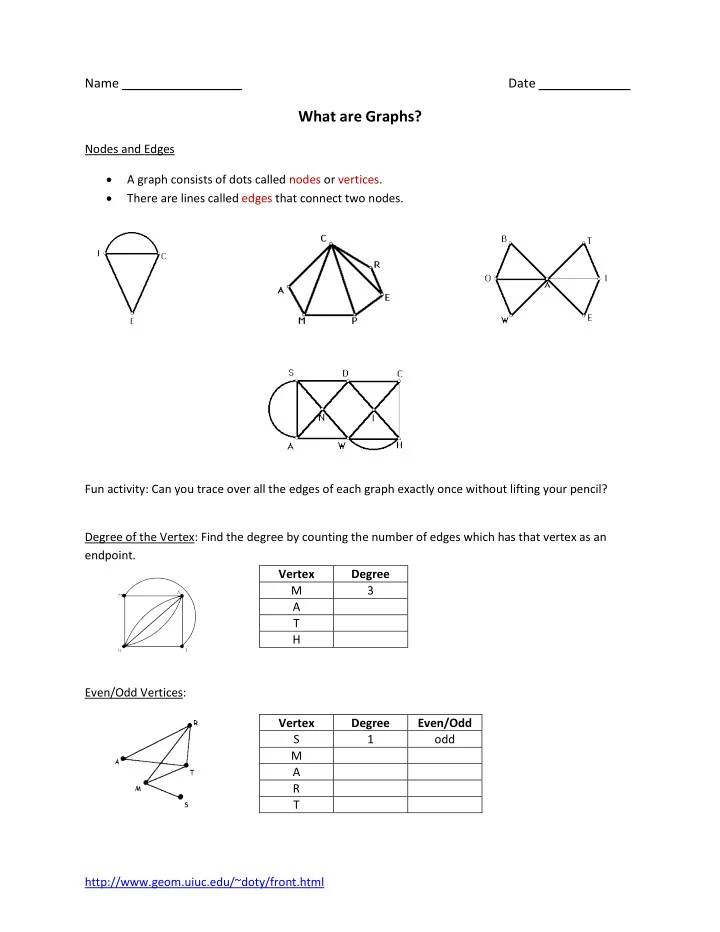

Name _________________ Date _____________ What are Graphs? Nodes and Edges A graph consists of dots called nodes or vertices. There are lines called edges that connect two nodes. Fun activity: Can you trace over all the edges of each graph exactly once without lifting your pencil? Degree of the Vertex: Find the degree by counting the number of edges which has that vertex as an endpoint. Vertex Degree M 3 A T H Even/Odd Vertices: Vertex Degree Even/Odd S 1 odd M A R T http://www.geom.uiuc.edu/~doty/front.html
What is an Euler Path and Circuit? For a graph to be an Euler circuit or path, it must be traversable. This means you can trace over all the edges of a graph exactly once without lifting your pencil. This is a traversal graph! Try it out: Euler Circuit For a graph to be an Euler Circuit, all of its vertices have to be even vertices. You will start and stop at the same vertex. Vertex Degree Even/Odd A B C D E F Euler Path For a graph to be an Euler Path, it has to have only 2 odd vertices. You will start and stop on different odd nodes. Vertex Degree Even/Odd A C Summary Euler Circuit: If a graph has any odd vertices, then it cannot have an Euler Circuit. If a graph has all even vertices, then it has at least one Euler Circuit (usually more). Euler Path: If a graph has more than 2 odd vertices, then it cannot have an Euler Path. If a graph has exactly 2 odd vertices, then it has at least one Euler Path, which starts at one of the odd vertices and ends at the other. Go back to the four graphs in the beginning. Are they Euler Circuits or Paths? http://www.geom.uiuc.edu/~doty/front.html
Name _________________ Date _____________ The Seven Bridges of Königsberg The Pregel River flows through the city of Kaliningrad, in Russia. There are two islands in the river, and seven bridges connect the island to each other and to the shores. In the 1700's, this city was part of East Prussia and was known as Konigsberg. It was common on Sunday for people to take walks over the bridges. These walks and bridges led to a problem. Over time this problem reached the famous mathematician Leonhard Euler. Euler described the problem himself in the following letter: The problem, which I understand is quite well known, is stated as follows: In the town of Konigsberg in Prussia there is an island called Kneiphof, with two branches of the river Pregel flowing around it. There are 7 bridges - a, b, c, d, e, f, and g - crossing the two branches. The question is whether a person can plan a walk in such a way that he will cross each of these bridges once but not more than once. I was told that while some denied the possibility of doing this and others were in doubt, no one maintained that it was actually possible. On the basis of the above I formulated the following very general problem … Euler came up with a theory that solved this problem. This lead to the creation of a new branch of mathematics called graph theory. Challenge: Can you figure this out? Look on the back for hints! http://www.geom.uiuc.edu/~doty/front.html
Euler simplified the picture by labeling the islands A and D and the shores of the river are B and C. The bridges are a, b, c, d, e, f, and g. Euler simplified his graph one more time. In this graph the vertices represent the land regions and the edges represent the paths over the bridges. Euler used this final graph to analyze if it is traversable. Using this graph, can you figure out if it is a path or a circuit? Bonus Question: Is it possible to have a graph with an odd number of odd vertices? Can you come up with an example of such a graph? http://www.geom.uiuc.edu/~doty/front.html
Name _________________ Date _____________ Handshaking Lemma It can be proven that it is impossible for a graph to have an odd number of odd vertices. The Handshaking Lemma says that: In any graph, the sum of all the vertex degrees is equal to twice the number of edges . Is this true? Let’s think about it! An edge connects two vertices. When you’re adding up the degree of each vertex, you’re counting the total number of edges connected to each vertex. This means you add each edge TWICE. So the sum of the degrees of all the vertices is just two times the number of edges. Let’s look at an example: Vertex A has degree 3. Vertex C also has degree 3. The sum of all the vertex degrees in this example is 6. It is also equal to twice the number of edges, doesn’t it? That’s because we essentially added each edge twice. This technique is called double counting, meaning that we count the same thing in two different ways. What does this tell us? It tells us that in any graph, the sum of all the vertex degrees is an even number . Why? Because no matter how many edges there are, the sum of all the vertex degrees equals twice the number of edges. Anything multiplied by 2 is always even! Which in turn implies that in any graph, the number of odd vertices is even. If we have an odd number of odd vertices, the sum of all the vertex-degree would be odd. That is clearly impossible, and therefore, a contradiction! You just understood a college-level proof. Congratulations! Why is it called the Handshaking Lemma? Imagine if vertices represent people in a meeting, and an edge represents a handshake between two people, then the total number of hands shaken is equal to twice the number of handshakes. http://www.geom.uiuc.edu/~doty/front.html
Recommend
More recommend